With Trump returning to the White House, the prediction market is experiencing an unprecedented wave of mainstream adoption. The latest big news is that Polymarket, the world's largest prediction market, has received tens of millions of dollars in investment from Donald Trump Jr.'s venture capital fund. The president's son is not only participating in the investment as 1789 Capital but will also join Polymarket's advisory board.
This investment in Polymarket may also indicate that the likelihood of an IPO is much greater than that of issuing tokens. 1789 Capital is also an investor in star companies like Anduril and SpaceX. According to insiders, 1789 Capital founder Omeed Malik began discussions with Polymarket CEO Shayne Coplan 18 months ago, but the investment was only formalized after the company established a clear legal path in the U.S. market.
Another interesting phenomenon is that most projects in the prediction market are still in a non-tokenized state, leaving relatively limited options for secondary market investors. Even for a prediction market giant like Polymarket, its most direct investment target is merely the UMA protocol, which provides oracle services.
Against this backdrop, Rhythm BlockBeats has selected six prediction market projects. From Flipr, which achieved a hundredfold increase in two months and embedded trading into social media for viral spread, to UMA and Azuro, which build infrastructure layers to serve the entire industry, and emerging protocols that achieve fully autonomous trading decisions through AI algorithms, these projects not only have unique technical architectures but also showcase distinctly different development paths in business models and user experiences. It is important to note that this article is for industry analysis and information organization only and does not constitute any investment advice.
Flipr: A Social Prediction Market with a Hundredfold Increase in Two Months
Flipr is positioned as the "social layer of prediction markets," with its core innovation being the integration of prediction market trading into the X (Twitter) platform, allowing users to place bets without leaving their social timeline.
Users simply need to tag @fliprbot in a tweet and specify the direction and amount, and the bot will parse the command and execute the trade immediately. The executed order will automatically be published as a quoted tweet, allowing others to copy, reverse bet, or share with one click. This design transforms traditional prediction markets from isolated website interfaces into a viral social experience, making each transaction naturally shareable content, significantly reducing user acquisition costs. Additionally, Flipr has introduced features such as up to 5x leverage, stop-loss and take-profit orders, and advanced order types.
In terms of team and financing, as of August 2025, the identities of the project team members have not been publicly disclosed, maintaining an anonymous operational status, and no equity financing rounds or venture capital investors have been announced to date.
Regarding token economic data, according to CoinGecko, as of September 1, 2025, the current price of $FLIPR is $0.009951, with a market cap of approximately $6.96 million. Notably, the token achieved a hundredfold increase from less than $2 million to a peak of $21 million within two months, demonstrating strong market momentum. However, after reaching a historical high of $0.02804 on August 25, the current price has dropped 64.5% from its peak, indicating a significant correction.
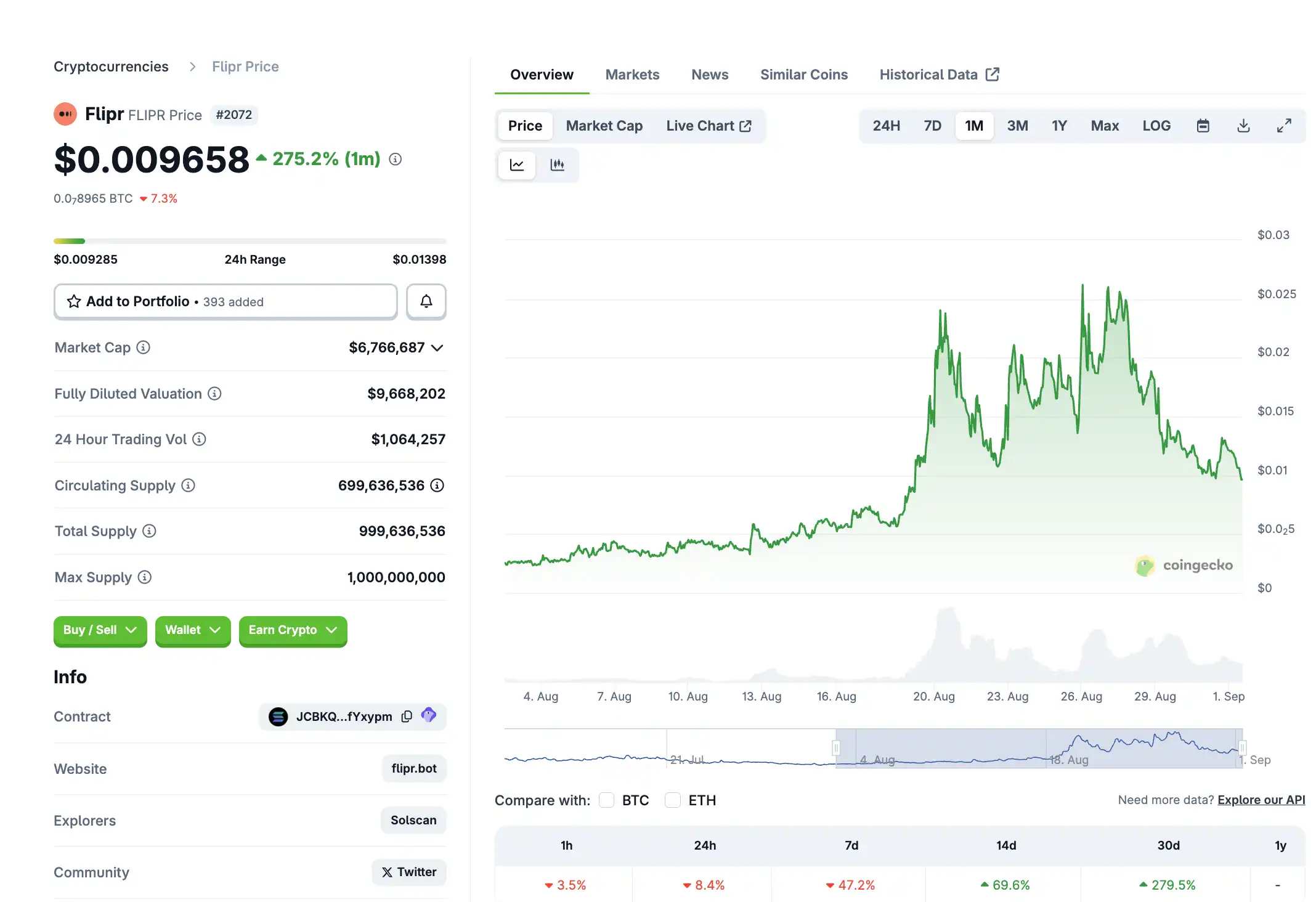
UMA: The King of Prediction Market Infrastructure
The status of UMA in the prediction market needs no elaboration, as well-known protocols like Polymarket and Across use UMA as a dispute resolution solution.
UMA (Universal Market Access) is positioned as an "optimistic oracle" protocol, with its core innovation being the dual-layer architecture of Optimistic Oracle and Data Verification Mechanism (DVM). According to UMA's official documentation, the protocol operates on a "presume correct, dispute verify" mechanism, allowing anyone to assert an external truth on-chain and stake collateral. If no one disputes it during the preset active period, it is deemed correct. This design allows for results to be provided without voting in the vast majority of cases, achieving speeds of seconds and incurring very low on-chain costs, while disputes are resolved through off-chain voting by UMA token holders within 48-96 hours.
In terms of financing, according to RootData, UMA has raised a total of $6.6 million since its launch in 2018, primarily in early stages. The $4 million seed round in December 2018 was led by Placeholder, with participation from well-known institutions like Coinbase Ventures, Dragonfly, Blockchain Capital, and Bain Capital Ventures. Notably, the project completed a $2.6 million funding round in July 2021 through an innovative Range Token structure, providing a non-dilutive liquidity improvement solution for DAO treasuries, with participants including Amber Group, Wintermute, and BitDAO. Compared to emerging DeFi projects that often raise tens of millions of dollars, UMA's financing scale is relatively conservative, reflecting the team's emphasis on product-driven growth rather than capital-driven expansion.
UMA employs a staking mechanism to ensure network security. According to official documentation, stakers lock UMA in the DVM 2.0 contract to vote on oracle disputes, earning approximately 30% target annual yield and the redistribution of funds from penalized incorrect voters. On August 12, UMA activated the "Management Optimistic Oracle V2" contract for Polymarket, limiting market proposal submissions to whitelisted members.
With Binance adding UMA trading pairs on August 26, market expectations for liquidity to further improve, but medium to long-term performance will still depend on whether it can effectively prevent token holder capture risks while maintaining decentralization principles.
As of September 1, 2025, the price of $UMA is $1.38, with a market cap of approximately $123.8 million, a 14-day increase of 8.9%, and a 30-day increase of 13.8%, indicating positive short-term performance. The token reached a historical high of $41.56 on February 4, 2021, and the current price has dropped 96.7% from its peak, but recent trends have been relatively stable.
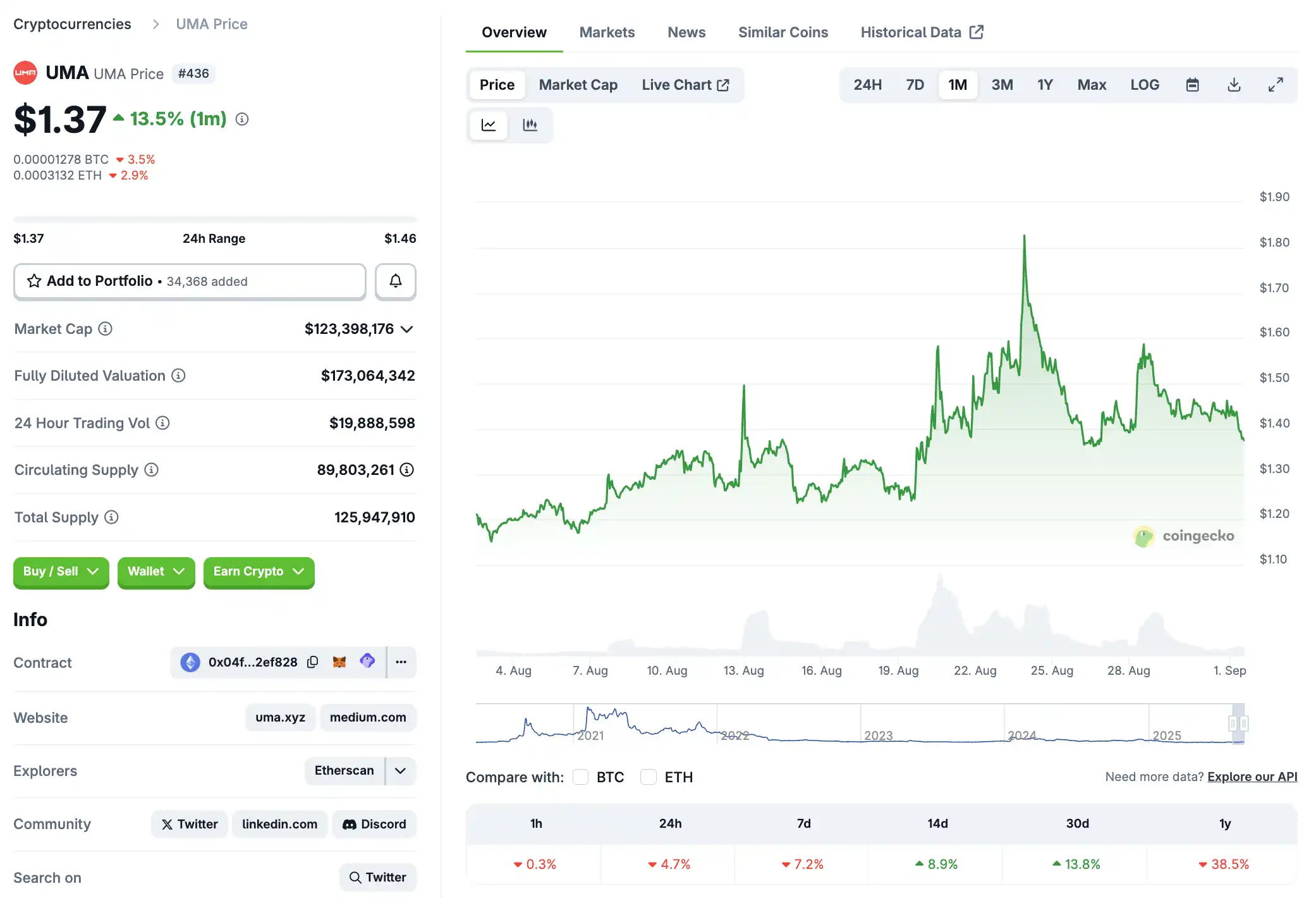
Augur: The Pioneer of Decentralized Prediction Markets
Augur is the first open-source decentralized prediction market protocol on Ethereum and can be considered a pioneer in decentralized prediction markets.
In a November article about prediction markets, Vitalik Buterin mentioned Augur: "As early as 2015, I became an active user and supporter of Augur (my name appears in the Wikipedia article). During the 2020 U.S. election, I made $58,000 through betting."
The Augur protocol crowdsources reports on real-world event outcomes from REP token holders, with inaccurate reports facing the risk of token forfeiture, while reporters whose reports align with consensus can earn a share of the platform's fees. More uniquely, Augur has designed a "forking to prevent consensus failure" mechanism, allowing REP holders to migrate to a new parallel universe when disputes cannot be resolved, making the economic cost of attacking the oracle extremely high. This can be seen as an alternative solution to UMA.
In terms of team composition, Augur was co-founded by three individuals with strong technical and financial backgrounds. According to Forbes, co-founder Joey Krug currently serves as co-CIO at Pantera Capital and became interested in prediction markets early on by developing horse racing analysis spreadsheets, ultimately designing Augur's game theory mechanism and leading Ethereum's first ICO. The other two founders, Jeremy Gardner and Jack Peterson, are also active in the blockchain ecosystem, and the project's advisory team includes industry heavyweights like Ethereum founder Vitalik Buterin and Intrade founder Ron Bernstein.
In terms of financing history, the project conducted an ICO from August to October 2015, selling 8.8 million REP tokens at a price of $0.602 each, raising approximately $5.3 million, with major investors including Pantera Capital, Multicoin Capital, and 1confirmation.
In terms of market feedback, $Augur is undergoing a community-led revival. It is advancing liquidity incentive programs and new research directions while facing challenges of insufficient liquidity, performing weaker compared to early prediction market platforms. As of September 1, 2025, the price of REP is $1.05, with a total supply of approximately 8.06 million, fully released, and a market cap of $8.5 million. The 30-day increase is 41.2%, and the one-year increase is 178%.
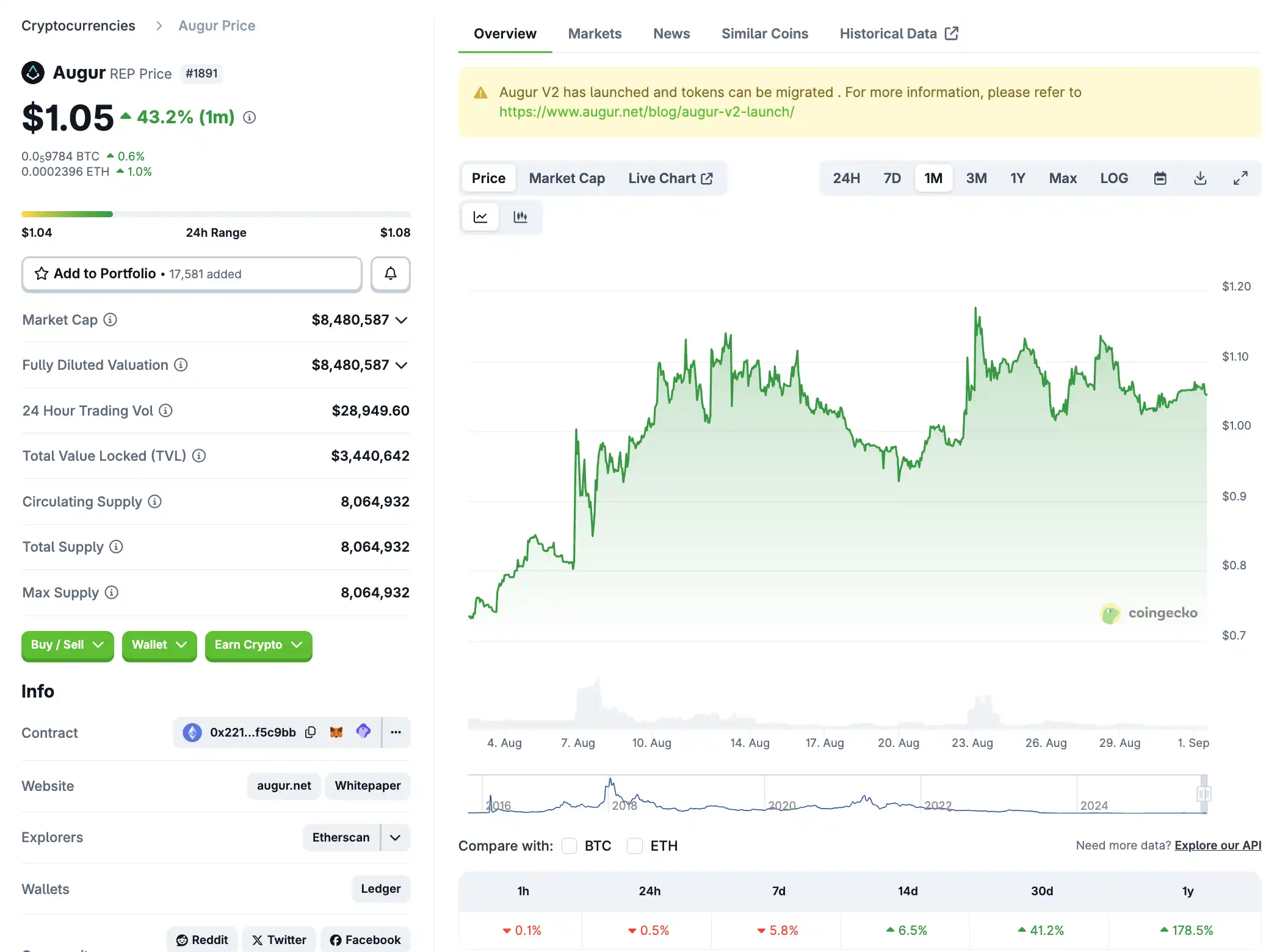
Azuro: A Team from Traditional Betting Markets
Azuro is positioned as an open white-label infrastructure layer, allowing anyone to launch on-chain sports and event prediction applications in minutes. According to the official technical documentation, the protocol builds a complete prediction market tech stack through three plug-and-play modules: singleton liquidity pools (allowing applications to access a shared funding pool and pay fees, with LPs earning floating returns and sharing the bookmaker's profits and losses), data provider/oracle layer (approved data providers create "conditional" markets and set initial enhanced capital and collateral), and front-end hooks (ready-made React components that allow brand sports betting or prediction games to launch without a backend). This design positions Azuro as the "Shopify of sports betting," allowing front-end applications to retain their own UI/UX while paying the protocol a share of betting profits and losses, while avoiding licensing and funding pool requirements.
The technical advantages of the protocol are reflected in its LiquidityTree virtual automated market maker (vAMM) and shared singleton LP architecture. This system handles odds setting, liquidity management, oracle data, and settlement processes, allowing the front end to operate without building its own trading engine. According to the official website, as of August 2025, Azuro supports over 30 real-time applications, with a total betting volume exceeding $530 million and approximately 31,000 unique wallets participating. Compared to traditional sports betting, its permissionless liquidity and transparent on-chain settlement provide front-end developers with competitive fixed odds while significantly lowering the entry barrier. The protocol currently operates on four chains: Polygon, Base, Chiliz, and Gnosis, with Polygon being the dominant chain, indicating that Azuro has gained significant positive attention and strategic positioning within the Polygon ecosystem.
In terms of team composition, Azuro is led by founders with a strong background in the traditional betting industry. Founder and CEO Paruyr Shahbazyan was the founder of Bookmaker Ratings and has over 10 years of experience in the iGaming industry. The financing history shows that Azuro has raised a total of $11 million through three funding rounds, with investors including well-known institutions such as Gnosis, Flow Ventures, Arrington XRP, AllianceDAO, Delphi Digital, and Fenbushi.
As of September 1, 2025, the total supply of $AZUR is 1 billion tokens, with a circulating supply of 222.95 million tokens (22%), priced at $0.007894, giving it a market cap of approximately $1.81 million. The token reached a historical high of $0.2396 on July 20, 2024, and the current price has dropped 96.6% from its peak, but it has recently shown strong rebound momentum, with a 24-hour increase of 41.5% and a 7-day increase of 41.8%.
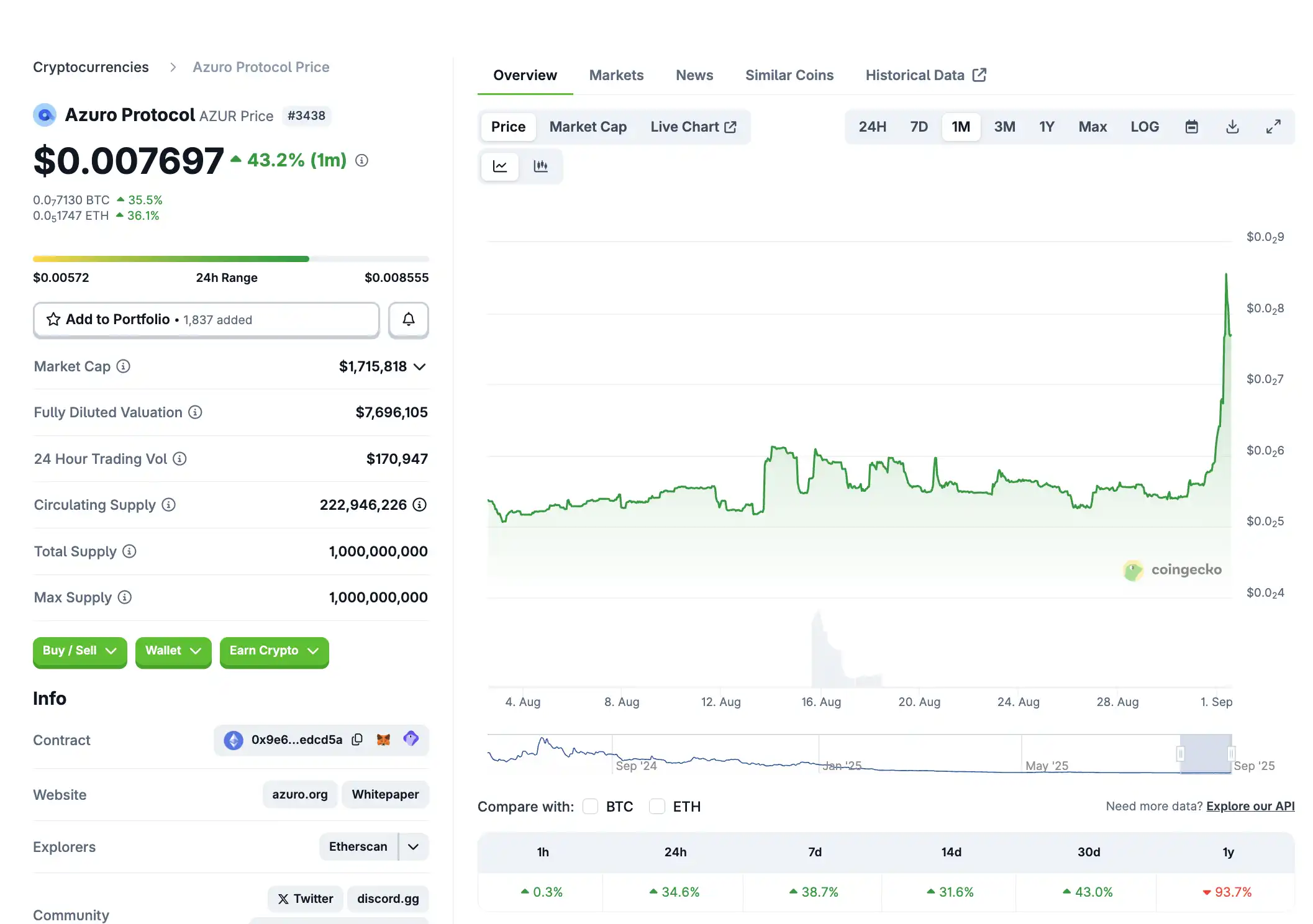
PNP Exchange: A Permissionless Prediction DEX on Solana
PNP Exchange is positioned as a permissionless prediction market DEX on the Solana chain, with its core innovation allowing any user to create yes/no markets on "any imaginable topic" and earn 50% of the trading fees from its joint curve pool. According to the project's official website, the platform employs an automated joint curve pricing mechanism to achieve instant on-chain settlement. Innovatively, PNP integrates an LLM oracle system, automatically resolving market outcomes through the consensus of Perplexity and Grok, along with on-chain data sources, successfully completing the first token market settlement without human intervention.
The recently launched "Coin MCP" module demonstrates the speed of its technological iteration, allowing users to create prediction markets with 1-hour settlements based on the price, liquidity, or market cap of any token. According to a social media announcement from the project founder on August 28, an upcoming SDK will allow AI agents to programmatically create and trade markets, while gas costs are expected to decrease by 90% in the next 2-3 days. This "Pump.fun-style prediction market" positioning distinguishes it from traditional platforms like Kalshi and Polymarket by removing the listing threshold, making it a user-generated content-driven meme prediction trading venue.
The $PNP token adopts a fully circulating design, with a total supply of approximately 965 million tokens. According to Birdeye data, as of September 1, 2025, the token price is $0.001665, with a market cap of approximately $1.6 million. The 30-day increase is 148.8%, and the 24-hour trading volume reached $176,000, all completed on the Meteora DEX.
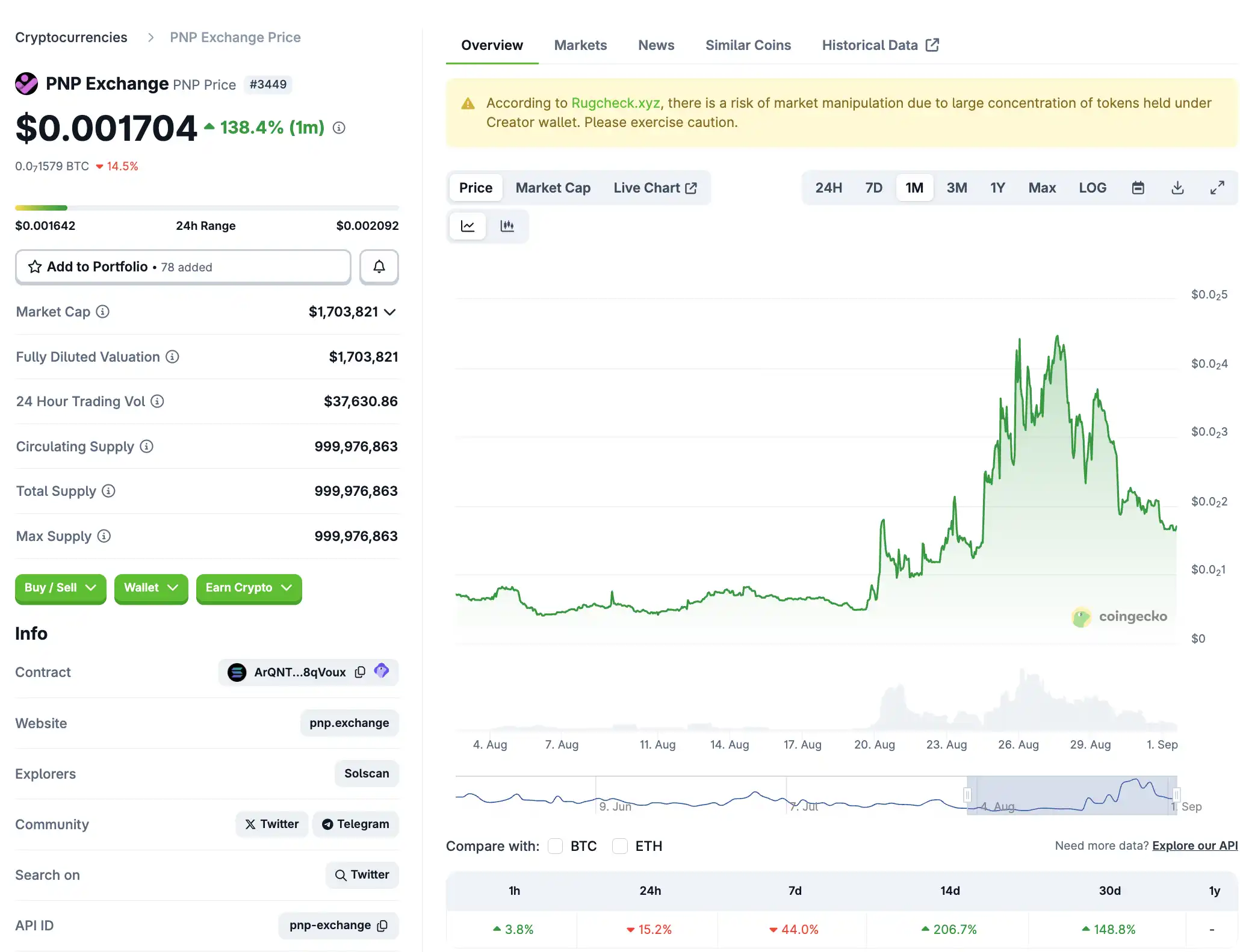
Hedgemony: AI-Driven Autonomous Trading Algorithms
Hedgemony is positioned as a "fully autonomous AI trading algorithm," specifically designed for real-time predictive trading based on global news and political sentiment. According to DexScreener information, the algorithm scrapes about 2,500 real-time news and political information sources per second, including Trump's X account tweets, Bloomberg, Reuters, and national media channels.
Hedgemony detects directional biases in global macro news headlines using a millisecond-latency Transformer language model, executing high-frequency leveraged futures trades within a time window of up to 60 seconds before information is publicly disseminated.
The protocol's innovation is also reflected in its "intent-driven execution layer" design concept. According to official sources, Hedgemony provides users with an AI agent capable of assembling exchange routing, dollar-cost averaging plans, yield delegation, and narrative-based portfolio strategies through prompt-based input. The system is currently running an MVP version on Arbitrum, with plans to expand to Base, HyperEVM, and Monad networks.
In terms of financing, Hedgemony has completed a seed round extension financing, self-reporting a valuation of approximately $1 billion, although the specific financing amount has not been disclosed. It is important to note that this valuation claim has not been confirmed by independent media reports or blockchain equity disclosures, and investors should approach such valuation data with caution, especially considering that the project is still in its early development stage.
Regarding token economic data, the total supply and circulating supply of the $HEDGEMONY token are both 1 billion tokens, adopting a fully circulating design. As of September 1, 2025, the token price is $0.005306, with a market cap of $5.3 million, and the fully diluted valuation is equal to the market cap. The 7-day increase is 64%, indicating positive short-term performance.
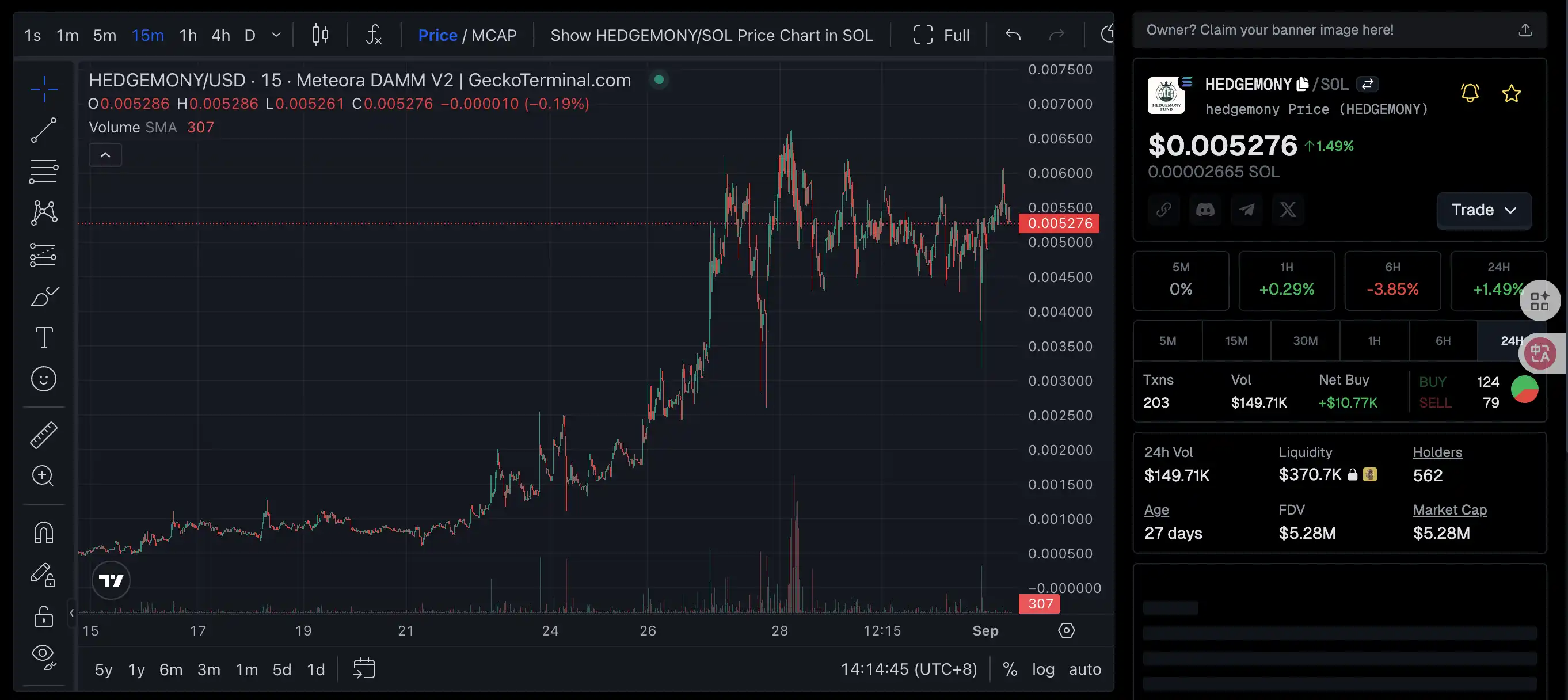
On-chain data shows 557 holding addresses, with total liquidity in the liquidity pool at $371,000, and 251 transactions within 24 hours, with 78 independent trading addresses participating. Notably, the top 10 holdings account for as much as 66.57%, with the largest holding address alone accounting for about 50%, indicating a high concentration risk. The project is still in a very early speculative adoption phase, exhibiting extremely high risk-reward dynamics.
免责声明:本文章仅代表作者个人观点,不代表本平台的立场和观点。本文章仅供信息分享,不构成对任何人的任何投资建议。用户与作者之间的任何争议,与本平台无关。如网页中刊载的文章或图片涉及侵权,请提供相关的权利证明和身份证明发送邮件到support@aicoin.com,本平台相关工作人员将会进行核查。




